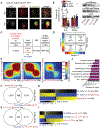Dopaminylation of histone H3 in ventral tegmental area regulates cocaine seeking
- PMID: 32273471
- PMCID: PMC7228137
- DOI: 10.1126/science.aaw8806
Dopaminylation of histone H3 in ventral tegmental area regulates cocaine seeking
Abstract
Vulnerability to relapse during periods of attempted abstinence from cocaine use is hypothesized to result from the rewiring of brain reward circuitries, particularly ventral tegmental area (VTA) dopamine neurons. How cocaine exposures act on midbrain dopamine neurons to precipitate addiction-relevant changes in gene expression is unclear. We found that histone H3 glutamine 5 dopaminylation (H3Q5dop) plays a critical role in cocaine-induced transcriptional plasticity in the midbrain. Rats undergoing withdrawal from cocaine showed an accumulation of H3Q5dop in the VTA. By reducing H3Q5dop in the VTA during withdrawal, we reversed cocaine-mediated gene expression changes, attenuated dopamine release in the nucleus accumbens, and reduced cocaine-seeking behavior. These findings establish a neurotransmission-independent role for nuclear dopamine in relapse-related transcriptional plasticity in the VTA.
Copyright © 2020 The Authors, some rights reserved; exclusive licensee American Association for the Advancement of Science. No claim to original U.S. Government Works.
Conflict of interest statement
Figures




Comment in
-
Epigenetic tinkering with neurotransmitters.Science. 2020 Apr 10;368(6487):134-135. doi: 10.1126/science.abb3533. Science. 2020. PMID: 32273456 No abstract available.
References
-
- Walther DJ et al., Cell 115, 851–862 (2003). - PubMed
Publication types
MeSH terms
Substances
Grants and funding
- R01 DA037257/DA/NIDA NIH HHS/United States
- F99 NS108543/NS/NINDS NIH HHS/United States
- R21 DA044486/DA/NIDA NIH HHS/United States
- R01 MH116900/MH/NIMH NIH HHS/United States
- R00 DA042111/DA/NIDA NIH HHS/United States
- F31 DA045428/DA/NIDA NIH HHS/United States
- T32 MH087004/MH/NIMH NIH HHS/United States
- R21 DA044767/DA/NIDA NIH HHS/United States
- P50 MH096890/MH/NIMH NIH HHS/United States
- R01 MH108842/MH/NIMH NIH HHS/United States
- R01 DA025983/DA/NIDA NIH HHS/United States
- P01 DA047233/DA/NIDA NIH HHS/United States
- DP1 DA048931/DA/NIDA NIH HHS/United States
- K00 MH122356/MH/NIMH NIH HHS/United States
- DP1 DA042078/DA/NIDA NIH HHS/United States
LinkOut - more resources
Full Text Sources
Other Literature Sources
Medical
Molecular Biology Databases

